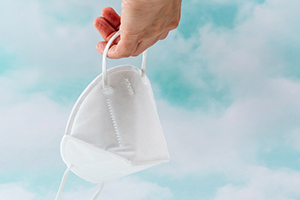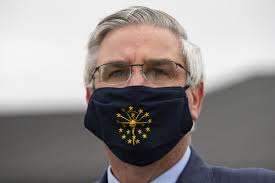
(INDIANAPOLIS) – Governor Eric Holcomb signed an executive order Friday to require face coverings be worn to slow the spread of COVID-19.
The order goes into effect today.

“Hoosiers have worked hard to get where we are today with businesses open and people back at work. We want to keep it that way. We don’t want to dial things back. Face coverings can and will help us blunt the increase of this virus,” Holcomb said.
While the order does not include criminal penalties it will be enforced by state and local health departments. It also outlines the requirements of face coverings in schools.
This is who the order will apply to:
- Anyone 8 or older in indoor public spaces, commercial entities or transportation services, or outside public spaces when people cannot socially distance.
- Masks are required in schools for students in grade third and higher and for faculty and staff, and volunteers, and anyone in schools. Masks also will be required for co-curricular and extracurricular activities, with the exception of strenuous physical activity.
- Exceptions will be made for medical purposes, strenuous physical activity, eating and drinking.
- Masks are strongly recommended for ages 2-7.
The order will be in effect at least until Aug. 26.
There is no federal mandate to wear a mask, and as of the end of July, there were still states that did not have mask orders.
Some states have only issued suggestions that people wear masks in public.
More than half of U.S. states have implemented some kind of mask requirement. President Trump also offered his strongest endorsement to wear masks.
Note that states and jurisdictions are updating their coronavirus rules often. Be sure to check with your local government to find out its current requirements.
Here are some of the other states who have issued statewide orders for masks:
- Alabama: The rule requires a mask for anyone older than 6 who’s in public and within 6 feet of someone who’s not a relative. Businesses are not required to prohibit people from entering if they lack masks, but they are allowed to refuse admittance.
- Arkansas: Face coverings are required statewide in all indoor environments where exposed to non-household members and 6-foot distancing cannot be assured. They’re needed outdoors too unless the distancing guidelines can be maintained or people live within the same household.
- California: A statewide order requires people to wear masks when inside or in line for any indoor public spaces, in health care settings like hospitals and pharmacies, while waiting for or riding public transportation and in outdoor spaces where it’s not possible to stay 6 feet apart from others.
- Colorado: Face coverings are required statewide in all indoor environments where exposed to non-household members and 6-foot distancing and, apply to people older than 10 and allowing for several exemptions like eating at a restaurant and exercising alone. He said police officers, firefighters, and EMTs also are exempt from the order because masks could hinder their ability to communicate.
- Connecticut: Residents are required to wear cloth face coverings in public spaces if they can’t maintain safe social distance. The mask must cover their nose and mouth. It must also be worn while in taxis, ride-sharing or similar services, or other public transportation.
- Delaware: Those over the age of 12 are required to wear face coverings in public when social distancing cannot be maintained. Coverings are recommended but not required for children ages 2-11. Businesses must require employees to wear face coverings while working in areas open to the public or if they are likely to come within 6 feet of other staff.
- Georgia: Gov. Brian Kemp strongly supports mask-wearing. He traveled the state this month to encourage face coverings. But he’s maintained for weeks that cities and counties can’t require them in public.
- Hawaii: Face coverings are required except for when doing permissible outdoor exercise activities and as long as social distancing requirements are maintained. Gov. David Ige issued an order that customers of essential businesses and employees who have contact with customers or products must wear masks.
- Kansas: Gov. Laura Kelly issued an executive order mandating the use of masks in public. The order requires every Kansan to wear a mask if they’re around other people, where individuals aren’t able to maintain 6 feet of social distancing. Children under age 5 and people with medical conditions are exempt from the mask requirements.
- Kentucky: Gov. Andy Beshear mandated wearing face coverings since July 10. They’re required inside or waiting in line, and when difficult to maintain 6 feet of distancing from others who aren’t members of the same household. People who are sick should wear a face covering while at home if they cannot keep a distance from others, and at all times whenever they leave home.
- Louisiana: Gov. John Bel Edwards announced a mandatory mask requirement for the state. It allows for parishes without high COVID-19 incidence to opt-out if they choose.
- Michigan: People must wear, at minimum, homemade, non-medical grade face coverings when they enter enclosed public spaces. Employers must provide at least cloth face coverings to their employees. Gov. Gretchen Whitmer’s order clarifies that businesses may not assume an unmasked customer cannot medically tolerate a face covering, though they can accept a customer’s verbal representation to that effect.
- Minnesota: A mask mandate went into effect on July 25 in public spaces across the state. Masks will be required in indoor settings like stores and restaurants.
- Maine: Residents in Maine are required to wear cloth face masks when they’re in public places and social distancing can’t be maintained.
- Maryland: People older than 9 must wear masks or cloth face coverings in retail spaces and on public transportation.
- Massachusetts:Gov. Charlie Baker ordered the wearing of masks and advised visitors to Massachusetts to quarantine for two weeks — except for several states nearby.
- Montana: Gov. Steve Bullock’s statewide mask mandate applies in counties with four or more active cases of COVID-19 and requires masks indoors and outdoors when social distancing can’t be observed.
- Nevada: Gov. Steve Sisolak announced last month that Nevada will mandate the use of face coverings in public places in an effort to stem an increase of coronavirus cases that has hit the state as casinos, restaurants and other businesses began reopening. “No shirt, no shoes, no mask, no service,” Sisolak said, distilling the policy down to a tagline.
- New Jersey: The state requires people to wear a mask in both indoor and outdoor public spaces and where social distancing is difficult to maintain.
- New Mexico: Everyone is required to wear a mask in public except when drinking, eating, or under medical instruction. It also requires people to wear face coverings while exercising, including at indoor gyms and fitness centers.
- New York: People must wear a mask in public situations where they’re unable to maintain 6-foot distance or in a public or private transportation vehicle. Gov. Andrew Cuomo has issued executive orders that direct employers to provide essential workers with masks for free if they’re in public and authorize businesses to deny entry to individuals not covering their faces.
- North Carolina: Everyone is required to wear face masks while in public places.
- Ohio: Buckeyes are required to wear a mask in public or where they’re unable to social distance. Gov. Mike DeWine announced that the mask mandate went into effect on Thursday evening for everyone age 10 and older. It will also not include anyone who has a medical condition that keeps them from wearing a mask.
- Oregon: Gov. Kate Brown ordered the wearing of wear face coverings in indoor public spaces on July 1 to slow the spread of the coronavirus. The guidance applies to businesses and members of the public visiting indoor public spaces, she said in a news release.
- Pennsylvania: Masks are required when entering any business in all counties in the yellow and green phases of reopening. The yellow phase eases some restrictions on work and social interaction, but closures of schools, gyms, salons, and limitations around large gatherings remain in place.
- Rhode Island: An executive order is extended to August 3rd for face coverings to be worn in public, both indoors and outdoors, where 6 feet of social distance cannot be maintained. Exceptions are made for children under 2 and anyone whose health would be negatively impacted by covering their faces.
- Texas: Residents are required to wear face coverings inside a public space or outside when it is not possible to keep 6 feet of social distancing from another person not from the same household. Children younger than 10 and people with a medical condition that does not allow them wear a mask are exempt.
- Virginia: Under Gov. Ralph Northam executive order people must wear masks inside stores, barbershops, restaurants, city buildings, on public transportation, or anywhere where people can congregate. People don’t have to wear a mask while eating and drinking at a restaurant while exercising, if they have trouble breathing or if health conditions prohibit wearing face coverings.
- Washington, D.C.: The District requires masks be worn by everyone in essential businesses. Mayor Muriel Bowser has ordered that masks need to be worn when going out to grocery stores and public transit.
- Washington State: Washington implemented a statewide requirement for people to wear facial coverings in public settings on June 26. The order requires face coverings when people are indoors in a public area, and outdoors in a public area when 6 feet of physical distancing can’t be maintained.
- West Virginia: Gov. Jim Justice issued an executive order last week mandating face coverings when people are inside buildings, though he has declined to impose a penalty for noncompliance.



